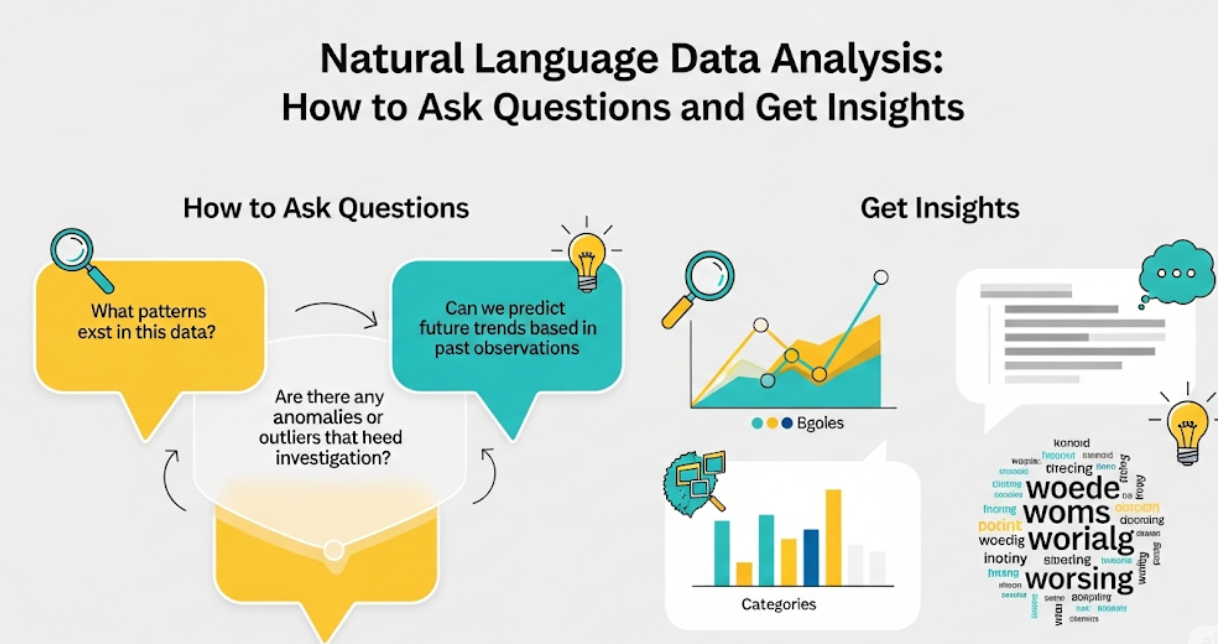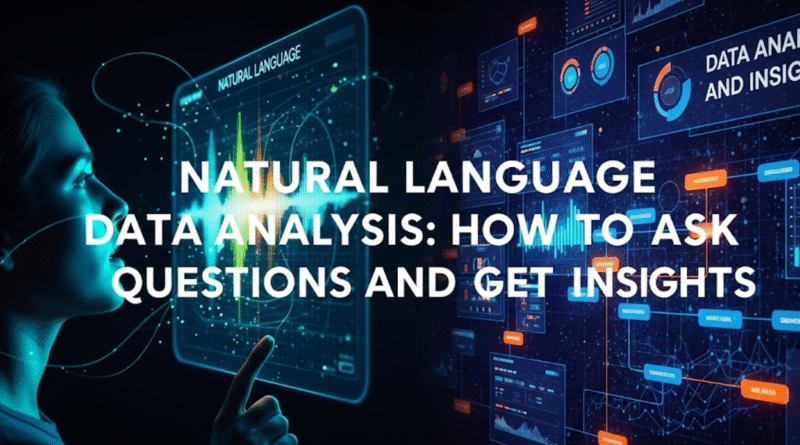Natural Language Data Analysis: How to Ask Questions and Get Insights
Today, the kind of information telling us how we understand our world is being collected in staggering volumes by businesses as well as average people every day. You need to have data, but that is not all – you need to be able to ask smart questions for valuable insights. An example of this is the great innovation delivered by natural language data analysis: it allows users to interact with their data in an unprecedented way, opening up the door for layering on large capabilities and machine learning on top of massive complex datasets, which has never been possible before because we have not had an open enough conduit into our data.
The Situation: No longer do you have to be an expert in coding and a data scientist to get real insight from your information. You can ask questions such as “What were our best-selling products last month?” using Natural Language Processing (NLP) tools, or “What are the riskiest churn customers?” and get instant, actionable insights.
In this complete guide, we will teach you how to ask questions and unlock the untold stories in your data. In this course you will learn the practical way, useful for a business owner or a student or even a person just curious about the data science revolution.
What Makes The Analysis of Natural Language Data So Powerful?
This is where the analysis of natural language data comes in, as it can connect human curiosity with machine intelligence. No need to write long, complex SQL queries or design intricate dashboards — query your data the way you would ask if a colleague knows the answer.
The Science Behind Conversational Analytics
These days, state of the art NLP systems can identify the INTENT behind questions that are put to them by authors. If you asked “Show me sales trends for the last quarter”, the system:
- Breaks down your language to understand what you refer to (sales, trends, period)
- Connects your words to database fields (maps to data structures)
- If you are not sure what queries to make to receive the only information that interests you
- Makes results available visually in the form of charts, plots, or tabular summaries
This is happening within seconds removing the traditional barriers between questions and answers.
Where Traditional Data Analysis Falls Short
It is common to mention that traditional business intelligence tools create diverse bottlenecks:
- Technology constraints: Most employees are not able to write SQL or use sophisticated analytics software
- Real-time: The need for IT departments to create custom reports
- It inhibits exploration: A pre-made dashboard is created by the one who designed the report; others often find it hard to ask spontaneous questions
- Communication gaps: Analysts using minimum business context
Natural language interfaces break down these barriers, and make data democratically accessible to every part of the company.
Core Principles for Turning Data into Questions Worth Thinking About
There are your insights — the quality of these varies heavily on how you frame your questions. Basically, these are the principles that distinguish strong inquiries from simple requests.
Specificity Drives Better Results
Vague questions produce vague answers. Compare these examples:
Weak: “How are we doing?”
Strong: “How much did it cost us to acquire a customer through digital marketing campaigns in Q3?”
Bad: “Give me customer data”
Good: “What customer segments do best in terms of LTV and churn?”
Context Adds Depth to Analysis
Context always matters – temporal, geographical, or categorical:
- Temporal: “How do we compare this month’s performance to the same period a year ago?”
- Geographical: Show regional differences in product preferences
- Categorical: Results by customer age segmentation
Progressive Question Sequences
Begin with broader themes—once you see what sticks, reel in your focus:
- How our total revenue is trending
- “Which product lines are doing better?”
- What are the elements that lead to success in our best performing product?
- What do these success factors mean for underperforming products?
Topic-Specific Smart Question Frameworks
There are different questions to address in a business case with this context or another. These are battle-tested templates for different analytical use cases.
The Performance Investigation Framework
A systematic business metric sequence:
- Current State: What are our current [metric] to target?
- Trend Analysis: What has the trajectory of this metric looked like over time (last [time period])?
- Driver Identification: Which factors correlate the most with changes in this metric?
- Segment Breakdown: How do customer/product/regional segmentations differ?
- Action Planning: “What if we could make [particular element] better by X percent?”
The Customer Behavior Exploration Framework
For customer-focused analysis:
- Segmentation Discovery: “What different types of customers are there in the data?”
- Journey Mapping: “What are the typical routes customers undergo before deciding to buy?”
- Value: “How cost effective are we at acquiring people who will be worth it, in time?”
- Retention Patterns: “Which behaviors differentiate a customer from the loyal or churn categories?”
- Opportunity Identification: “Where are we leaving potential additional customer value on the table?”
The Operational Efficiency Framework
For process optimization:
- Bottlenecks: “At what point of our process are delays occurring most often?”
- Resource Utilization: “Are we getting the most out of our [staff/equipment/budget]?”
- Quality Factors: “What conditions are associated with best outcomes?”
- Cost Optimization: “Where can we cut down on the budget, without compromising on quality?”
- Understanding Scalability: “How far can we go before those limitations come into play?”
Natural Language Analysis Tools & Platforms
There are a range of competencies available in the market that will help to analyze conversational data.
Business Intelligence Platforms
| Platform | Best For | Key Features | Learning Curve |
|---|---|---|---|
| Tableau Ask Data | Visual exploration | Natural language to charts | Medium |
| Microsoft Power BI Q&A | Office integration | Conversational queries | Low |
| ThoughtSpot | Enterprise search | Google-like data search | Medium |
| Qlik Sense Insight Advisor | Automated insights | AI-suggested questions | Medium |
Specialized NLP Analytics Tools
MonkeyLearn: Text Analysis and Sentiment Mining
- Best for: Social media listening, customer sentiment analysis
- Strengths: Pre-trained models, easy integration
Lexalytics: Enterprise-grade text analytics
- Best for: Large-scale document processing
- Strengths: Customizable models, multi-language support
Google Analytics Intelligence: Conversational analytics built in
- Best for: Website and marketing data
- Strengths: Automatic insights, mobile accessibility
Open-Source Solutions
For power users who want to personalize their experience:
- Apache Superset: An open-source answer to commercial BI tools
- Streamlit: Python-based dashboard creation
- Grafana: The graph panel for time series data viewing
Pro-Level Questioning Techniques
Once you have learned the ropes of basic question asking, equip yourself with these advanced high level questions to delve down even deeper.
Comparative Analysis Questions
Look across dimensions to find hidden patterns:
- “Which channels are the most effective for customer acquisition and retention and how do customer-acquisition costs differ across mediums?”
- “What are the product features which generate customer satisfaction in different age groups?”
- “How do experience level and team size affect the productivity of employees?”
Predictive Questioning Strategies
Predict future trends from historical data:
- “If you keep going like this— what will your revenue be next quarter?”
- “Who are the types of customers that will most likely upgrade their subscriptions?”
- “How much do we need to keep stocked so that we never stock out of anything?”
Causal Relationship Exploration
Dig into cause-and-effect relationships:
- “What are the events that most often lead to top sales days?”
- “What is the relationship between customer service response time and retention?”
- “What impact does each marketing effort have on brand awareness?”
Anomaly Detection Questions
Spot trends that may indicate something interesting, identify patterns that seem out of reach (good or bad):
- “What days or times demonstrate the strangest activity behaviors?”
- “What sets customers apart from within their cohort?”
- “Which of our actual results differ the most from predictions?”
Watch Out for Common Pitfalls
Unfortunately, some mistakes potentially can lead to false conclusions even with the availability of powerful tools.
The Correlation vs. Causation Trap
Just because 2 metrics move together does not mean one causes the other. Always ask follow-up questions:
- What else changed during this period?
- “Have we seen this relationship repeatedly across applicable conditions?”
- “What if we tried controlling for other variables?”
Sample Size and Statistical Significance
Avoid pattern recognition in small datasets. Verify your findings:
- “How much data supports this?”
- “If we were to conduct this same study, but exclude the outliers — would there be any patterns that carry over?”
- “Is this difference just the result of random variation or is it a statistically significant difference?”
Survivorship Bias in Data Analysis
Important details missing from your dataset:
- “What data are we missing from this analysis?”
- “Have we become so focused on success that we are no longer learning from failures?”
- “What might our findings have looked like had we included missing data?”
Over-Reliance on Automated Insights
AI suggestions are starting points, not answers:
- Validate automated insights with common sense
- Probe deeper: Ask follow-up questions to unpack the ‘why’ behind patterns
- Provide alternative explanations for trends observed

How to Build Your Own Personal Data Questioning Toolkit
Human beings can learn to think analytically, but this is a trait that requires practice and resources.
Daily Practice Exercises
- Analyze Business News: Read business news and question the data that is reported
- Personal Data Exploration: Investigate your own habits with fitness trackers, expense apps, or time logs
- Investigate a Public Dataset: Work with datasets freely accessible from government or research organizations
Essential Skills to Develop
Statistical Literacy
- Topics of mean, median, and mode and when to use each
- Statistical significance and confidence intervals
- Correlations and what they mean
Business Acumen
- Industry-specific metrics and benchmarks
- Seasonal patterns and cyclical trends
- Competitive analysis frameworks
Critical Thinking
- Question assumptions and biases
- Consider alternative explanations
- Evaluate evidence quality
Resources for Continuous Learning
Online Communities
- Reddit’s r/analytics and r/datascience
- Stack Overflow for technical questions
- LinkedIn analytics groups
Educational Platforms
- Coursera’s data analysis courses
- Khan Academy’s statistics modules
- Business intelligence YouTube channels
Industry Publications
- Harvard Business Review’s analytics articles
- MIT Technology Review data science stories
- Industry-specific trade publications
Case Studies and Real World Success Stories
Learning from others’ success can ignite sparks in your analytical journey.
Read more: From Raw Data to Insights: A Step-by-Step Guide with AI Software
Retail Chain Optimization
Natural language analytics were used by a mid-sized retail chain to enhance inventory management. By asking questions like “Which products are sold with higher rotation in each region?” and “Which variables predict seasonal demand upticks?”, they:
- Decreased inventory holding costs by 23%
- Improved product availability by 18%
- Increased profit by making better purchases
The trick was asking geographic questions that traditional analysis failed to address and which showed regional preferences.
Healthcare Patient Outcomes
A regional hospital system embraced data questioning in order to improve patient care. Instead of simply tracking average metrics, they inquired:
- “Which patient characteristics are associated with longer recovery?”
- “Which treatment protocols have been most effective for the same group of conditions?”
- “What is the relationship between staffing levels and patient satisfaction scores?”
This translated to reducing their average length of stay by 15% and increasing patient satisfaction scores by an average of 12%.
E-commerce Personalization
Here is an example of how an online retailer had a behavioral approach in transforming their recommendation engine:
- “Which products are bought together most often?”
- “What browsing behavior is a top indicator of likely purchase?”
- “In which customer segment do seasonal trends occur?”
Through this method, average order value went up by 28% and customer retention jumped to 22%.
Frequently Asked Questions
Q: Do natural language processing tools require technical skills?
A: No, that’s the point! These tools are created specifically for non-technical users. Although you should be familiar with your business domain, it has very little to do with coding skills.
Q: How precise are natural language query results?
A: Depends on the quality of your data and how clear your questions are. Accuracy scores from 85-95% are common with a good mix of structured data and questions that have unambiguous answers. Always verify important findings.
Q: Can natural language tools perform complex multi-step analysis?
A: Contemporary workflows support more complicated queries. If you do not ask multiple questions in sequence — that is, if your answer to question A has a complex rationale involving query B — then your problem might be better framed as several simpler problems.
Q: What is the most common mistake you see beginners make?
A: Not starting small enough with their initial questions. Begin with something specific and work your way out after you determine there is an interest. Compare “this month’s sales to last month by product category” vs “Show me sales data.”
Q: How do I know whether my insights are actionable?
A: Good insights answer the “so what” and “now what” questions. They should suggest clear steps or decisions. If answering your finding does not change your behavior, go deeper.
Q: Can I trust automated insights and recommendations?
A: You can trust them enough to get you started but not to get you across the finish line. Automated insights are good at pattern detection but do not have business sense. Always validate with domain knowledge.
Q: How often should I analyze my data?
A: That would depend on your industry and data velocity. Analyze daily for the quickest-moving metrics, weekly for operational data, monthly for strategic analysis. The most important thing is the regularity of frequency.
Q: What if my queries in natural language don’t give the expected results?
A: Rephrase with more specific terms, check your data structure, or break complex questions down into simpler components. Most tools improve with clearer, more comprehensible language.
Your Next Steps in Data-Driven Decision-Making
Natural language data analysis is a fundamental shift in how we interact with information. When you master the craft of asking the right questions, you are not just analyzing data — you are unlocking the strategic advantage that comes from truly comprehending your business, customers, and opportunities.
The journey from data newcomer to insight expert requires practice, curiosity, and a willingness to dig deeper when your first answers bring up more questions. Begin with simple queries about metrics that already make a lot of sense to you, and incrementally advance into more complex topics as you gain confidence.
Remember that your critical thinking remains the most influential analytics tool. Technology enables individuals to understand and retain information more quickly than ever, but human judgment, ingenuity, and business acumen are irreplaceable.
Use natural language analytics as a telescope to observe expanding amounts of data. Still, always use your own understanding to interpret what you observe.
In our data-rich world, the winners will not be the businesses (or people) with the fanciest tools — they will be those who ask the most intelligent questions. You do not compete in complexity of analysis, but you always win on clarity and ability to ask relevant questions.
Start today. Choose a single business metric you care about, write a specific question regarding it and start investigating. Now, you know how to hear the stories of your data.

